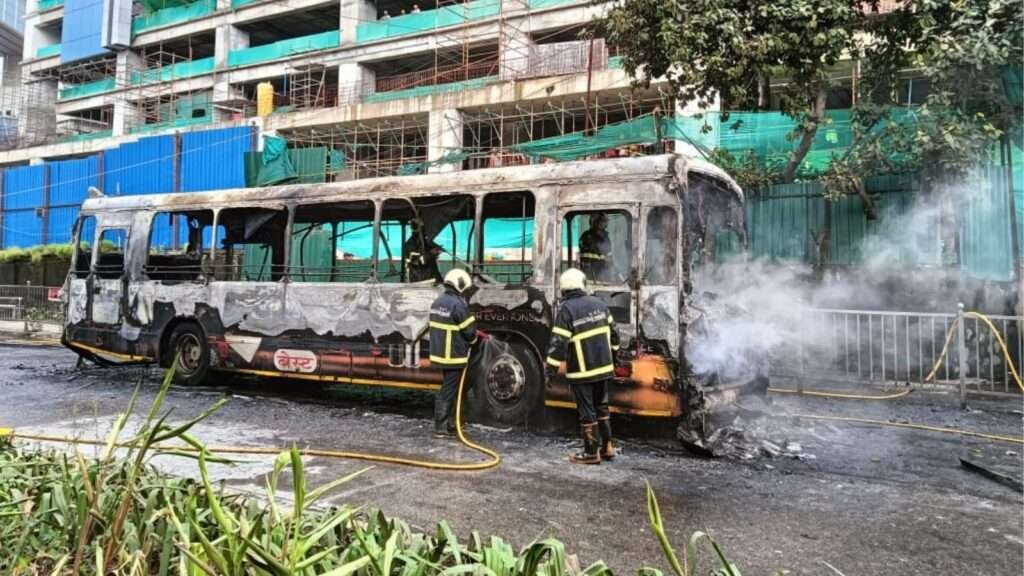BEST Bus Fire on LBS Road
The bus, belonging to Dharavi Depot, was operating on route number 303 between Bandra and Mulund. The fire started while the bus was taking a U-turn at the Gandhi Nagar signal on LBS Road. The bus had just dropped off passengers and only the driver and conductor were on board when the fire broke out.

Possible Cause of the Fire
Initial reports suggest that the fire may have been triggered by overheating of the engine or electrical systems. Authorities are conducting an investigation to determine the exact cause.
Driver and Conductor Escape
The fire started around 1:30 pm, and both bus driver Sanjay Suryawanshi and conductor Ajit Sarate managed to get out in time. Sarate suffered minor burns on his right hand, while Suryawanshi was unharmed, though his license was lost in the fire.
Quick Response from Firefighters
Two fire brigade vehicles arrived on the scene shortly after the fire was reported. The fire was brought under control by 2:15 pm, preventing further damage.
Fire Contained Without Major Injuries
Officials from the Maharashtra Police and fire department confirmed that the fire was quickly contained. Arun Shirsat, Accident Officer, expressed relief that no passengers were on board, and the driver and conductor sustained only minor injuries.
Investigation Underway
A detailed investigation is being carried out to identify the cause of the fire. Authorities are working to ensure similar incidents don’t occur in the future.
Conclusion
The BEST bus was leased from Mateshwari Transport, a Mumbai-based company. Traffic in the area was unaffected, and the incident was handled swiftly without any public harm.
How IGNICOP Could Have Prevented the Fire Risk
In this incident, the presence of an Early Warning Apparatus and Communication System (EWACS), like IGNICOP®, could have significantly reduced the risk of the fire spreading or even prevented it altogether.

Continuous Monitoring and Early Detection
IGNICOP®, a revolutionary fire hazard annunciator system, could have continuously monitored the engine’s health and pressure levels, ensuring that any signs of overheating or electrical failure were detected in real time. By proactively monitoring the fire safety system, IGNICOP® would have alerted the bus operators or maintenance teams to potential issues before they became critical.
Instant Alerts and Response
One of the key features of IGNICOP® is its ability to send instant notifications. If installed in the bus, the system would have detected any deviation in the engine’s pressure or overheating of critical components and immediately sent SMS alerts to key stakeholders within 5 seconds. This would be followed by phone calls within 10 seconds, allowing first responders and maintenance teams to react swiftly, minimizing the risk of fire or further damage.
At Basic Elements, we believe that fire safety should never be compromised. Our innovative solutions, like IGNICOP®, are designed to provide comprehensive protection for critical infrastructure. We specialise in conducting thorough fire safety audits, identifying potential risks, and recommending tailored solutions to mitigate those risks effectively.
Key Benefits of IGNICOP®:
Dashboard Accessibility for Fleet Management
For a public transport network like BEST, IGNICOP® would have provided real-time access to the health status of all buses through an easy-to-use Admin Dashboard. This would enable fleet managers to monitor multiple buses at once, ensuring they stay informed of potential risks and can address issues quickly before they escalate into dangerous situations.
Reducing Risk Velocity and Enhancing Safety
By deploying IGNICOP®, the risk velocity—the speed at which a critical failure can cause harm—would have been significantly reduced. The system’s early warnings would have ensured that maintenance teams could intervene before the situation turned into a full-blown fire. This not only protects lives and assets but also ensures the continued safety of Mumbai’s public transport network.
Conclusion
While the fire in this particular BEST bus was contained quickly, installing an Early Warning Apparatus and Communication System (EWACS) like IGNICOP® could have prevented the fire risk altogether by providing real-time monitoring and instant alerts. As the first of its kind, IGNICOP® serves as a guardian for both lives and property, contributing to safer public spaces and more resilient infrastructure.







